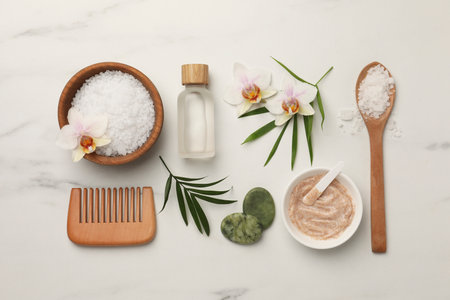Understanding the Ayurvedic Approach to Hair Care
Ayurveda, India’s ancient system of holistic wellness, offers a profound perspective on scalp and hair health. Unlike generic, one-size-fits-all solutions, Ayurveda recognises that every individual is unique, guided by their specific dosha constitution—Vata, Pitta, or Kapha. According to traditional Indian wisdom, maintaining healthy hair begins with balancing these doshas and harmonising the body’s natural elements—earth, water, fire, air, and ether. This means that your scalp care should be as personalised as your diet or daily routine. In Ayurveda, a healthy scalp is seen as the fertile soil from which lustrous hair grows. If imbalances occur—such as excess heat (Pitta), dryness (Vata), or oiliness (Kapha)—the scalp can become prone to issues like dandruff, hair fall, or dullness. By understanding your dosha and embracing herbal remedies rooted in Indian tradition, you pave the way for strong roots and vibrant locks. This personalised approach not only honours your unique constitution but also connects you with time-tested rituals that have nurtured Indian hair for centuries.
Key Indian Herbs Used in the Mask
The strength of any authentic Ayurvedic hair mask lies in its carefully selected blend of traditional Indian herbs, revered for centuries for their scalp and hair benefits. Below is a closer look at five staple botanicals commonly included in these masks, each playing a unique role in nourishing the scalp and supporting healthy, glossy hair.
| Herb | Traditional Role | Benefits for Scalp & Hair |
|---|---|---|
| Amla (Indian Gooseberry) | Rasayana (rejuvenator) for hair | Rich in vitamin C, amla strengthens hair roots, supports healthy follicles, and helps prevent premature greying. |
| Bhringraj (Eclipta alba) | Keshya (promotes hair growth) | Known as “King of Hair,” bhringraj revitalizes scalp health, reduces hair fall, and encourages dense, thick growth. |
| Shikakai (Acacia concinna) | Natural cleanser | Cleanses the scalp gently without stripping natural oils, leaving hair soft and manageable. |
| Neem (Azadirachta indica) | Pitta-pacifying herb | Its anti-bacterial properties help address dandruff and soothe itchy, irritated scalps. |
| Hibiscus (Hibiscus rosa-sinensis) | Keshya (hair vitalizer) | Nourishes follicles, enhances shine, and helps keep the scalp cool—ideal for Indian summers. |
Together, these potent herbs form the backbone of the Ayurvedic hair mask formula. Their synergy not only nurtures the scalp but also addresses common concerns like dryness, dullness, and thinning. By harnessing India’s botanical heritage, this special blend supports strong, lustrous hair naturally—the way our grandmothers have trusted for generations.
![]()
3. Traditional Preparation Methods
In Indian households, the art of preparing Ayurvedic hair masks is a cherished tradition passed down through generations. The process begins with families selecting high-quality herbs such as amla, bhringraj, neem, and hibiscus. These ingredients are often sourced from local markets or home gardens to ensure freshness and potency. According to custom, women gather together to clean and sort the leaves, fruits, and roots, sharing stories as they work.
The grinding of herbs is a vital step in achieving an effective hair mask. Traditionally, a stone grinder known as a sil batta or ammikkal is used. This manual technique not only preserves the natural oils and nutrients but also infuses the preparation with a personal touch. Today, some families may use modern mixers or blenders for convenience, but many still prefer the old-fashioned method for its authenticity.
When it comes to choosing between fresh and dried ingredients, preferences vary across regions. In South India, fresh hibiscus flowers and curry leaves are commonly used straight from the garden. In contrast, North Indian households may rely on sun-dried amla or fenugreek seeds during off-seasons. Both approaches have their merits: fresh herbs offer vibrant color and aroma, while dried ones are believed to have concentrated properties.
Once ground into a fine paste, the herbal mixture is blended with nourishing liquids like coconut milk, yogurt, or rose water to create a creamy mask. This blend is then gently massaged onto the scalp using circular motions—a gesture considered both therapeutic and bonding within families. Such rituals not only nurture healthy hair but also strengthen familial ties and connect individuals to their cultural roots.
4. Step-by-Step Application Ritual
Embracing the Ayurvedic Tradition
The process of applying an Ayurvedic hair mask is more than a beauty routine; it is a mindful ritual that draws from centuries-old Indian traditions. By honouring each step, you invite balance and nourishment to both scalp and spirit.
Preparation: Setting the Space & Ingredients
- Gather Your Ingredients: Ensure your herbal hair mask is ready, mixed with pure water, milk, or curd as per traditional recipes.
- Create a Calm Atmosphere: Light a diya (lamp) or incense stick to invoke a sense of peace, aligning with Ayurveda’s emphasis on holistic well-being.
- Warmth Matters: Slightly warm the mixture for enhanced absorption and comfort during application.
Step-by-Step Application Process
| Step | Description |
|---|---|
| 1. Sectioning Hair | Divide your hair into small sections using a wide-tooth comb to ensure even application of the mask. |
| 2. Root-Focused Application | Apply the herbal paste generously to the scalp first, massaging gently in circular motions to stimulate blood flow and awaken hair follicles. |
| 3. Length & Tips Coverage | Smooth the remaining mask along the length and tips of your hair for complete nourishment. |
| 4. Scalp Massage Techniques | Use your fingertips (never nails) to perform slow, rhythmic massages—this not only aids absorption but also relaxes the mind, embodying Abhyanga (Ayurvedic self-massage). |
| 5. Embrace Relaxation | Sit comfortably and take deep breaths; Ayurveda teaches that calmness enhances the efficacy of herbs by balancing doshas (body energies). |
| 6. Time & Warmth Ritual | Cover your head with a soft cotton cloth or shower cap to retain gentle warmth. Leave the mask on for 30-45 minutes—the heat helps active botanicals penetrate deeply. |
| 7. Rinsing Off | Rinse with lukewarm water and mild herbal shampoo, ensuring no residue remains. |
The Importance of Ritual in Indian Hair Care
The deliberate rhythm of these steps echoes Indian traditions where every act is infused with intention. Scalp massage not only improves circulation but also reduces stress—a key cause of hair issues according to Ayurveda. The warmth and time allow potent herbs like amla, bhringraj, and neem to deliver their full benefits, leaving your scalp balanced and your hair renewed in true Ayurvedic fashion.
5. Cultural Significance of Herbal Hair Masks
In India, the use of Ayurvedic herbal hair masks goes far beyond personal care; it is deeply woven into the cultural fabric and traditional beauty rituals. These nourishing treatments are not only valued for their efficacy but also for the sense of connection they foster within families and communities.
Pre-Wedding Beauty Rituals
Ayurvedic hair masks play an essential role in pre-wedding ceremonies, where brides-to-be indulge in special beauty routines to ensure lustrous, healthy hair for their big day. It is common for family members to gather and apply homemade herbal masks rich in amla, shikakai, and bhringraj as part of the Haldi or Mehendi events. This ritual not only beautifies but also symbolizes blessings and good fortune for the brides new journey.
Festive Grooming Traditions
During major Indian festivals like Diwali and Karva Chauth, using a herbal hair mask is considered an auspicious way to cleanse and rejuvenate. Families often prepare fresh masks with natural ingredients to pamper themselves, reflecting the importance of self-care during times of celebration. The aromatic blends of herbs and oils evoke nostalgia and create a festive ambiance, making these moments both relaxing and meaningful.
Generational Beauty Secrets
The art of preparing Ayurvedic hair masks is a cherished tradition passed down through generations. Grandmothers share their wisdom about unique combinations—such as hibiscus petals mixed with fenugreek seeds or neem leaves blended with coconut oil—instilling values of natural wellness from a young age. These recipes are treasured family secrets, reinforcing bonds and preserving India’s holistic approach to beauty.
Symbolism and Community
Herbal hair masks represent more than just beauty—they reflect health, purity, and respect for nature. Their preparation and application are often communal acts that strengthen relationships and nurture a sense of belonging. By embracing these time-honored practices, individuals celebrate both personal well-being and India’s vibrant cultural heritage.
6. Tips for Maintaining a Healthy Scalp in the Indian Climate
The Indian climate, with its shifting monsoons, scorching summers, and high humidity, poses unique challenges to scalp and hair health. To maximize the benefits of your Ayurvedic Hair Mask for a healthy scalp, it’s essential to tailor your care routine in harmony with local weather patterns and cultural practices.
Choosing the Right Oils for Your Scalp
Ayurveda recommends different oils based on your dosha and seasonal needs. During hot summers, coconut oil or brahmi oil can cool and soothe the scalp, while heavier oils like sesame or bhringraj are ideal for nourishing dryness in winter months. Always warm the oil slightly before application to enhance absorption and relaxation.
Adjusting Your Routine With Seasonal Changes
Monsoon Care
The monsoon brings excess moisture that can lead to fungal growth and dandruff. Use lighter oils such as neem or tea tree-infused blends for their antimicrobial properties. Avoid keeping your scalp wet for long periods and ensure thorough drying after washing.
Summer Protection
Protect your hair from intense sun exposure by applying a thin layer of coconut oil before heading outdoors. Wash more frequently to remove sweat and dust build-up, but avoid harsh shampoos that strip natural oils. Incorporate cooling ingredients like aloe vera gel into your mask or post-wash routine.
Cultural Practices: The Role of Traditional Coverings
Indian women have long used dupattas, scarves, or pallu ends not just as style statements but also as practical shields against environmental stressors. Wrapping your hair with a soft cotton dupatta protects against UV rays, dust, and pollution while allowing the scalp to breathe. This simple habit can reduce breakage and help retain moisture after using herbal masks.
Additional Tips
- Avoid tying wet hair tightly; let it air dry first to prevent scalp infections.
- Comb gently with a wide-tooth wooden comb to distribute natural oils evenly from root to tip.
- Incorporate weekly massages using Ayurvedic oils to boost circulation and mask absorption.
By integrating these traditional wisdoms with modern Ayurvedic hair care practices, you can nurture a truly healthy scalp that thrives even in India’s challenging climate.


